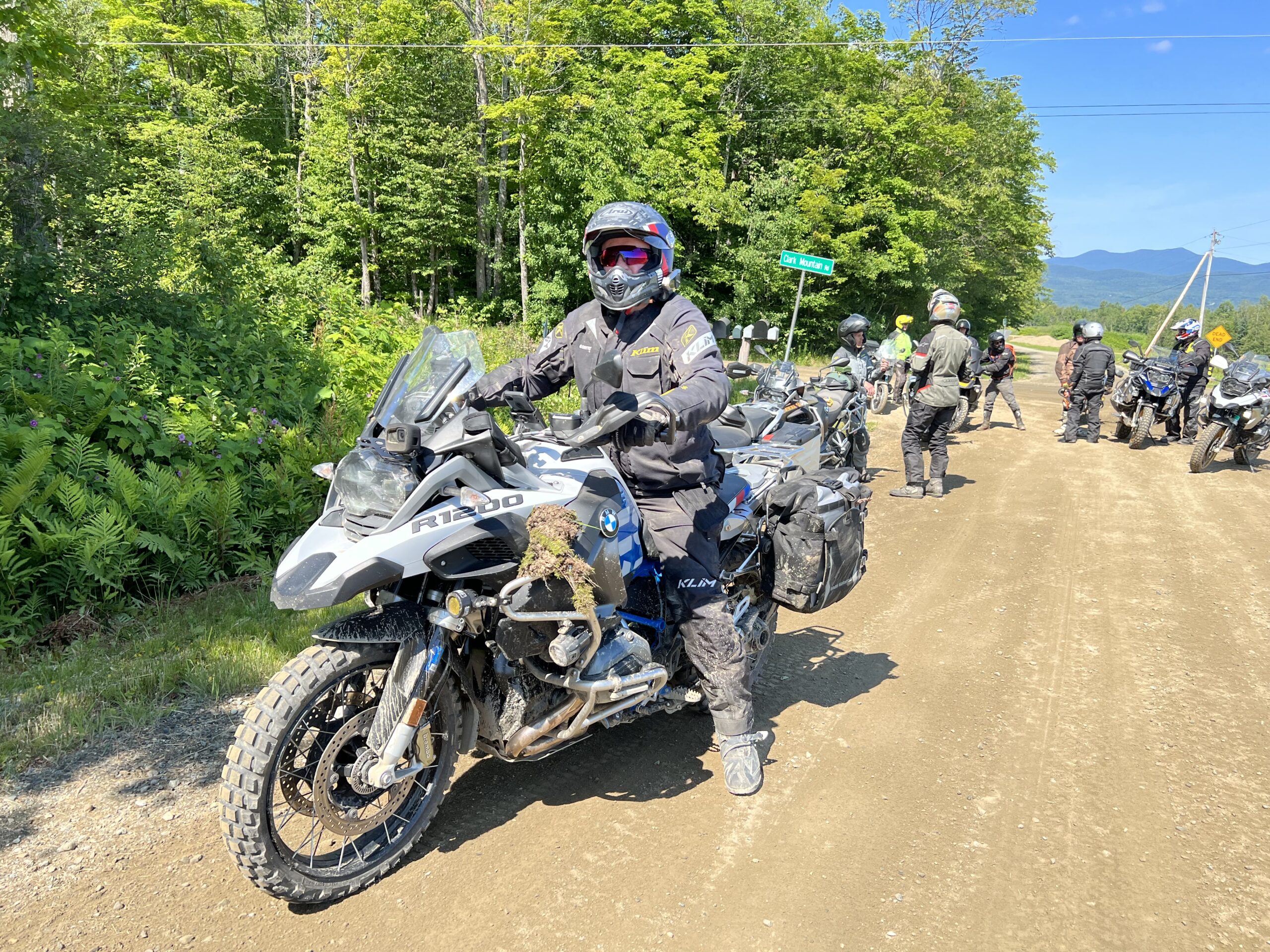

Reclaiming Mobility: Mid-Foot reconstruction success at NMC
While out for a leisurely motorcycle ride last summer, John Collinsworth of St. Albans found himself between the proverbial rock and a hard place.
“A group of friends and I were riding our motorcycles on a UTV trail near Troy, Vermont. Riding in the left side track, I brushed up against an embankment, stalling the motorcycle and pinning my left foot between a rock that was jutting front the embankment, and the foot-peg of my motorcycle.”
Unaware at the time, Collinsworth had shattered and dislocated several bones of the left midfoot, resulting in an injury called a Lisfranc fracture.
While the injury occurred around noon that Sunday, Collinsworth said, “I rode the 40-minute ride back home and waited until around 6 p.m. Monday, before going to the Northwestern Medical Center Urgent Care.”
At urgent care, Collinsworth was seen by Physician Assistant Kristie Oliver, who realized the severity of his injury, partially due to his inability to bear weight. “She diagnosed the injury correctly, which was amazing as it is such a rare injury,” he said.
Three days later, Collinsworth met with foot and ankle surgeon Kristin Kindred, DPM, for consultation.
CT scans revealed a comminuted left ankle Lisfranc fracture-dislocation, with associated tarsometatarsal fractures one, two, three, and four. Essentially the middle-foot bones were severely broken and fragmented, including the bones that extend to the big toe, and the middle three toes.
The injury required immediate attention to avoid further damage, therefore surgery was scheduled for just eight days later.
“Lisfranc fractures can be treated with open reduction internal fixation (ORIF) or with primary arthrodesis of the affected joints,” said Dr. Kindred, who specializes in foot and ankle reconstruction.
Open reduction is an open surgical procedure in which broken bones are realigned, rather than a closed reduction, which is performed without the need for surgery, such as a cast.
Internal fixation refers to the components used to stabilize bones, such as screws, plates or rods. Arthrodesis is joint fusion, in which the surgeon manually straightens the damaged joint, removing cartilage, and stabilizes the bones so that they heal together.
“The first, second and third tarsometatarsal (TMT) joints are small, non-essential joints and the foot still functions very well without mobility of these joints,” said Dr. Kindred. “In fact, the stability of the arch and midfoot depends on these joints being secure and stable. Most often stability is more important than motion.
The fourth and fifth TMT joints are more essential to preserve motion, so ORIF is often chosen for these, she said. “In John’s case I did fusion of the first, second and third, and ORIF of the fourth,” as the level of fragmentation and joint destruction made the selection of primary fusion necessary.
Collinsworth, now 71, said he was initially apprehensive about the prospect of surgery, yet the early consultations with Dr. Kindred were confidence inspiring.
“This was my first operation – ever. My first time under anesthesia,” he said. “I had no trepidation about any of it the day of surgery, I was confident in the ability of the surgeon and comfortable with the process.”
For Dr. Kindred, surgical planning began by closely assessing fracture patterns on the CT scan. “I look at where the fragments are and try to visualize how to fix them in surgery.”
Once in the OR, “I make incisions over the joints and carefully mobilize and retract the nerves, tendons and vasculature between the skin and bone.”
There are often bone fragments blocking reduction of the joints, she explained. “Any fragments I remove during reduction are then morselized and used as graft to fill any bone voids,” as was the case during Collinsworth’s repairs.
“For arthrodesis, I remove any remaining cartilage in the joints and then reduce the fractures and compress the joints using clamps and wires. Then I place plates and screws over the joints to hold the reduction and compression,” she said, explaining the process of joint fusion. Finally, the skin is closed in layers and the patient is placed into a splint.
“I will say that John’s fracture was one of the hardest ones I’ve ever fixed because of the comminution (fragmentation.) Because of the fractures and the joint dislocation, I had to put in longer plates, and reduce the joints and the fractures at the same time,” Dr. Kindred said.
Following surgery, Collinsworth was to remain non-weight bearing on his left foot for eight weeks, while patients with less severe recoveries often endure only six weeks, according to Dr. Kindred.
Collinsworth continued wearing the Ortho-Glass splint he was given at Urgent Care, until a padded short leg cast was applied on August 11.
“I was able to get around with crutches and a knee walker. On September 8, I graduated to a tall walking boot. I began partial weight bearing nine weeks post-surgery and then full weight bearing in running shoes mid-October,” he recalled.
He began physical therapy at Cobblestone on October 5, working with Christine Sears, PT, through January 2023.
“The physical therapy sessions with Crissy were integral to my successful recovery,” Collinsworth said. “I looked forward to each physical therapy session,” especially the leg strengthening exercises and therapies for improving balance.
“Thank you, Crissy, for motivating me to work to restore mobility in my foot and ankle. I attribute the reclaimed range of motion and strength in my foot and ankle to your expertise,” he said.
“My biggest challenge was the initial transition to crutches and navigating the stairs. Clinically, I do not know how anything could have possibly been better,” Collinsworth said.
“I am extremely fortunate to enjoy this level of recovery, which is about 98-to-99-percent by my own estimate. I have read so many accounts of others who have sustained similar injuries, and years later are still suffering. There are so many stories of misdiagnoses or lack of adequate post-surgery care,” he said, mentioning a Facebook page dedicated to such.
“Lisfranc injuries can be misdiagnosed, or entirely missed, up to 20-percent of the time,” Dr. Kindred confirmed. “It would be more common to miss than the more subtle sprains of the foot, as there is often less swelling and bruising than with higher energy injuries.”
The published incidence of Lisfranc injuries has been reported to be 14/100,000 persons-years. “It is often thought of as a high velocity injury that occurs from a motor vehicle accident, falling from a height, or falling off a motorcycle/ATV,” said Dr. Kindred. “However, up to 30-percent of these injuries occur without a high energy mechanism; from things like missing a step, sprains or ground level falls.”
Back on the Bike
With two adult sons and five grandchildren, Collinsworth values the ability to renew his active lifestyle. Having ridden motorcycles for nearly 50 years, it would be difficult to give it up now.
“I generally ride about 6,000 miles a year,” he said, recalling a round-trip ride to Sturgis, South Dakota in 2021. Just nine months after his accident he was back in the saddle.
“I just went for my first ride since my injury on Saturday, April 15. I plan to continue riding but intend to limit my off pavement riding to gravel roads,” he said.
“Please consider wearing proper protective gear when riding. Had I not been wearing the boots that I was, the injury would probably have been even more severe,” he offered to motorcyclists who may be reading this.
“Based upon my experience the best advice I would give someone is not to delay in getting an injury checked out. I’m certain that my waiting for more than 24-hours and continuing to bear weight on my foot exasperated my injury.”
Having previously worked at UVMMC for 15 years, Collinsworth said, “Although I was not directly involved in patient care, that experience increased my appreciation for the dedication of health care professionals, and our medical system as a whole.”
Finally, his words to the surgeon who reconstructed his foot: “Dr. Kindred, as a community, we are privileged to have a surgeon of your caliber practicing at Northwestern Medical Center. Your expertise is apparent, in that I experienced absolutely no nerve damage from the surgery, essentially no pain, and the most positive outcome I could have wished for.” —
Story by: Sarah Parsons West
Photo Courtesy: John Collinsworth
Photo Caption: (man on motorcycle) – John Collinsworth sits on his motorcycle just ten minutes after an accident that shattered the bones in his left foot, resulting in a severe Lisfranc fracture. “I was supporting over 600 pounds of motorcycle and body weight on my injured foot,” said Collinsworth. “Notice the heavy boots I was wearing; the helmet is concealing the grimace on my face.”
Who, Why or What is a Lisfranc?
Skilled physicians were in high demand on the battlefield during the brutal Napoleonic Wars (1803-1815). Out of necessity, Dr. Jacques Lisfranc de St. Martin, a French gynecologist, was pulled in to help operate on wounded soldiers.
Dr. Lisfranc created a new technique in 1815, while treating a calvary soldier whose foot became stuck in the stirrups during a dismount. Compromised blood flow to his lower limb caused a gangrenous foot, requiring amputation. Lisfranc described the surgery as an ‘amputation of the foot through the tarsometatarsal articulation’ (middle-foot bones).
The eponymous Lisfranc injury has come to mean a dislocation or fracture-dislocation injury at the tarsometatarsal joints, also known as the Lisfranc joints.
Dr. Lisfranc pioneered several other operations during his medical career in Paris.

